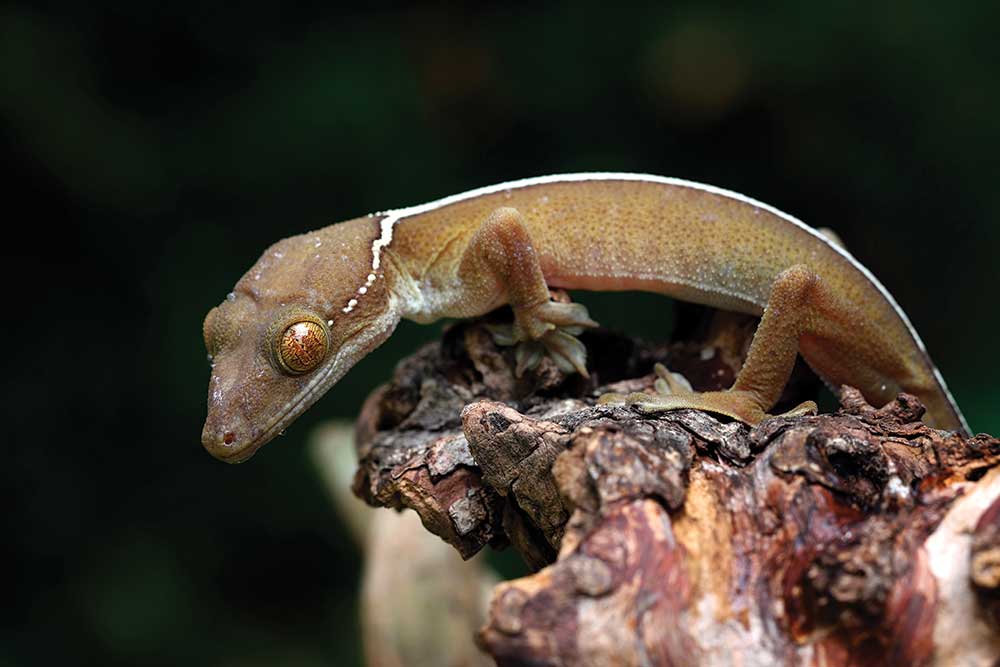Gekko vittatus is an ideal species for the intermediate to advanced reptile keeper.
The skunk gecko (Gekko vittatus) is also known as the lined gecko due to the stripe that goes down its back. An arboreal species, the skunk gecko is known to be a very fast and skittish species that would make for a great display animal in a beautiful bioactive enclosure. Native to the rainforests of Indonesia, the skunk gecko is a climber and has toe pads that enable it to stick to many surfaces. It is a species ideal for intermediate to advanced keepers considering its behavior.
Skunk Gecko Availability
While not as popular as crested geckos and leopard geckos, you can find skunk geckos at reptile shows and online breeders. They are not a common species in the reptile hobby. When you find one, ensure that its skin is smooth and vibrant. It should be well attuned to its environment, with clear eyes and a skittish demeanor. If it seems slow or lethargic, consider a different specimen. Likewise, when working with an online purveyor of this species, insist on a written health guarantee.
Skunk Gecko Size
Skunk gecko’s grow to about 9 to 10 inches in length.
Skunk Gecko Life Span
In the wild, the skunk gecko lives about 3 to 5 years. In captivity, they have been documented to live 15 years and more with appropriate care. Seven to 10 years is the average lifespan for this species in captivity.
Skunk Gecko Housing
Because the skunk gecko is an arboreal species, choose an enclosure that is taller than longer or wider. A 20 gallon tall enclosure is a good minimum, with larger enclosures better. These lizards will explore almost all aspects of their enclosure. Provide plenty of foliage and hiding spots for your skunk gecko. These animals are climbers, so include plenty of vertical branches such as bamboo, cork bark, and vines. Consider a bioactive enclosure for this species, as this will provide the necessary hiding spots while also helping with humidity. A variety of substrates can be used, including coco fiber, peat moss, and cocohusk. These substrates will help with humidity.
Heating and Lighting for the Skunk Gecko
Keep your skunk gecko’s enclosure at 75 degrees Fahrenheit (23.9 degrees Celsius) at night and 85 to 90 degrees Fahrenheit (29.4 to 32.2 degrees Celsius) during daylight hours. A heat lamp on the mesh screened top of the enclosure will help you to achieve these temperatures and will help create a temperature gradient from top to bottom. Invest in a quality thermometer or thermometer gun so you know the daily temperatures are ideal in the enclosure. The gecko is a Ferguson Zone 1 reptile. It is crepuscular or shade dweller. Choose a UVB light that has a UVI Zone Range of 0 to 0.7 with a maximum UVI Zone range of 0.6 to 1.4 at the gecko’s basking area, which should be about 8 inches above the basking area. For more on reptile lighting and UVB, visit Reptile Lighting Information
Skunk Gecko Food
Skunk geckos are insect opportunists and will feed on live and dusted crickets, dubia roaches, mealworms, and wax worms, and black soldier fly larvae. They will also eat commercial diets for crested geckos as well as mashed fruits such as bananas and papayas.
Skunk Gecko Water and Humidity
Skunk geckos in the wild live in tropical rainforests. Its enclosure should mimic that as much as possible. Keep the humidity between 70 and 80 percent.
Skunk Gecko Handling and Temperament
Unlike a leopard gecko or even crested gecko, skunk geckos are nimble and delicate. . . and fast. They are not a touchy feely species like the aforementioned geckos. Males should be kept separately. The skunk gecko will make a nice display animal. If you desire a gecko that you can hold more often, consider the crested gecko or leopard gecko.
For more on the skunk gecko, visit Elizabeth Ralston’s Skunk Gecko History And Care.


